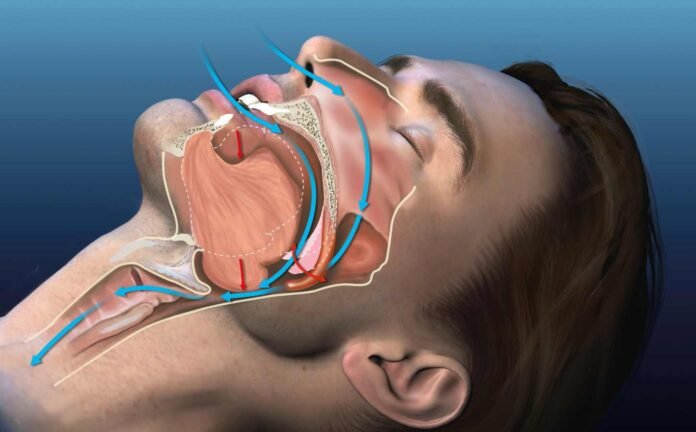Sleep-related hypoxemia is a condition that affects many people during their sleep.
Sleep-related hypoxemia occurs when the level of oxygen in the blood drops below normal levels, leading to a range of symptoms and potential health risks. This condition is often associated with sleep-related breathing disorders, such as obstructive sleep apnea, and can have serious consequences if left untreated.
During sleep, the body’s respiratory system slows down, and the muscles that control breathing relax. For some individuals, this can result in a partial or complete blockage of the airway, which leads to a reduction in the amount of oxygen that reaches the lungs. This reduction in oxygen levels can cause a range of symptoms, including snoring, gasping for air, and restless sleep. Over time, sleep-related hypoxemia can lead to more serious health problems, such as high blood pressure, heart disease, and stroke.
Treatment for sleep-related hypoxemia typically involves addressing the underlying sleep-related breathing disorder. This may involve the use of continuous positive airway pressure (CPAP) therapy, which involves wearing a mask during sleep that delivers a steady stream of air to keep the airway open.
Other treatments may include lifestyle changes, such as weight loss or avoiding alcohol and sedatives before bedtime. With proper diagnosis and treatment, individuals with sleep-related hypoxemia can improve their sleep quality and reduce their risk of developing serious health problems.
Understanding Sleep-Related Hypoxemia
Sleep-related hypoxemia is a medical condition that is classified under the international classification of sleep disorders. It is a disorder that is characterized by a decrease in blood oxygen level during sleep, leading to hypoxemia.
Pathophysiology and Causes
Sleep-related hypoxemia can be caused by a variety of factors, including breathing disorders such as obstructive sleep apnea, central sleep apnea, and hypoventilation. Lung conditions such as chronic obstructive pulmonary disease can also lead to hypoxemia during sleep.
During sleep, the muscles that control breathing relax, leading to a decrease in airflow to the lungs. This can cause a drop in blood oxygen levels, leading to hypoxemia. Additionally, high altitude can also cause hypoxemia during sleep, as the air at high altitudes has lower oxygen levels.
Symptoms and Diagnosis
Sleep-related hypoxemia can cause a variety of symptoms, including shortness of breath, fatigue, headache, and excessive daytime sleepiness. Morning headaches are also a common symptom of sleep-related hypoxemia.
Diagnosis of sleep-related hypoxemia is typically done through a sleep study, also known as polysomnography. During a sleep study, the patient’s breathing, heart rate, and blood oxygen levels are monitored to determine if hypoxemia is present. Pulse oximetry, which measures oxygen saturation in the blood, may also be used to diagnose sleep-related hypoxemia.
In conclusion, understanding sleep-related hypoxemia involves knowing the pathophysiology and causes of the disorder, as well as its symptoms and methods of diagnosis. By identifying and treating sleep-related hypoxemia, individuals can improve their quality of life and reduce the risk of complications associated with hypoxemia.
Management and Treatment
Lifestyle and Behavioral Interventions
For individuals with sleep-related hypoxemia, lifestyle and behavioral interventions can be effective in reducing symptoms and improving sleep quality. These interventions include weight loss, avoiding alcohol consumption, and improving sleep hygiene.
Obesity is a common risk factor for sleep-related hypoxemia, and weight loss can improve symptoms by reducing the amount of fat in the upper airway that can obstruct breathing.
Avoiding alcohol consumption can also be helpful, as alcohol can relax the muscles in the upper airway and worsen breathing problems during sleep.
Improving sleep hygiene, such as establishing a regular sleep schedule and creating a comfortable sleep environment, can also improve sleep quality and reduce symptoms.
Medical and Therapeutic Approaches
Medical and therapeutic approaches may also be necessary for individuals with sleep-related hypoxemia, particularly if lifestyle interventions are not effective or if the condition is caused by an underlying medical condition.
For individuals with chronic obstructive pulmonary disease (COPD) or obstructive sleep apnea, continuous positive airway pressure (CPAP) therapy may be recommended. CPAP therapy involves wearing a mask over the nose or mouth during sleep, which delivers a continuous stream of air to keep the airway open and prevent breathing problems.
For individuals with central sleep apnea or sleep-related hypoventilation, other forms of positive airway pressure therapy, such as bi-level positive airway pressure (BiPAP) or adaptive servo-ventilation (ASV), may be recommended. These therapies provide different levels of air pressure during inhalation and exhalation to improve breathing.
In some cases, oxygen therapy may be necessary to improve oxygen levels in the blood. Oxygen therapy involves using a machine to deliver oxygen through a mask or nasal cannula.
Individuals with obesity hypoventilation syndrome (PDF), upper airway resistance syndrome, alveolar hypoventilation syndrome, respiratory disorders, heart disease, or lung conditions may require additional medical help to manage their condition and improve sleep-related hypoxemia symptoms. It is important to work with a healthcare professional to determine the most appropriate treatment plan.
Sleep-Related Hypoventilation: Causes, Symptoms, and Treatment

Sleep-related hypoventilation occurs when a person’s breathing rate decreases, causing a buildup of carbon dioxide in the bloodstream. This can lead to symptoms such as fatigue, headaches, and difficulty concentrating during the day.
Continue reading: Sleep-Related Hypoventilation
Discover the Tongue Trick for Better Sleep: The U.S. Marine’s Secret

This tongue trick is designed to help you fall asleep in just two minutes by stimulating a specific nerve in your tongue, known as the “sleep nerve,” to promote relaxation and better sleep.
Continue reading: Discover the Tongue Trick for Better Sleep





